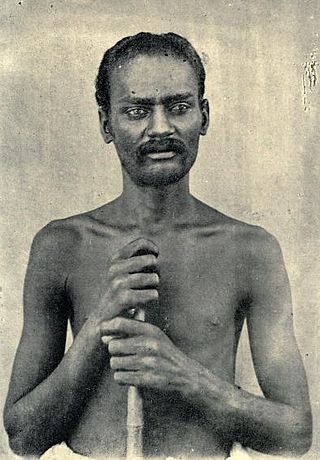
The Lepcha are among the indigenous peoples of the Indian state of Sikkim and Nepal, and number around 80,000. Many Lepcha are also found in western and southwestern Bhutan, Darjeeling, the Koshi Province of eastern Nepal, and in the hills of West Bengal. The Lepcha people are composed of four main distinct communities: the Renjóngmú of Sikkim; the Dámsángmú of Kalimpong, Kurseong, and Mirik; the ʔilámmú of Ilam District, Nepal; and the Promú of Samtse and Chukha in southwestern Bhutan.

The Adi people are one of the most populous groups of indigenous peoples in the Indian state of Arunachal Pradesh. A few thousand are also found in the Tibet Autonomous Region, where they are called the Lhoba together with some of the Nyishi people, Na people, Mishmi people and Tagin people.

Bhotiya or Bhot is an Indian and Nepali exonym lumping together various ethnic groups speaking Tibetic languages, as well as some groups speaking other Tibeto-Burman languages living in the Transhimalayan region that divides India from Tibet. The word Bhotiya comes from the classical Tibetan name for Tibet, བོད, bod. The Bhotiya speak numerous languages including Ladakhi. The Indian recognition of such language is Bhoti / Bhotia having Tibetan scripts and it lies in the Parliament of India to become one of the official languages through Eighth Schedule of the Indian Constitution.

Toto is a Sino-Tibetan language spoken on the border of India and Bhutan, by the tribal Toto people in Totopara, West Bengal along the border with Bhutan. It is also spoken in Subhapara, Dhunchipara, and Panchayatpara hillocks on India-Bhutan border in Jalpaiguri district, West Bengal (Ethnologue).
Totopara is a village in the Madarihat-Birpara CD block in the Alipurduar subdivision of the Alipurduar district of West Bengal, India.

The Dhimal or Dhemal are an Kirati ethnic group residing in the eastern Terai of Nepal. They are a Sino-Tibetan-speaking ethnic group of the eastern Terai. They mainly reside in Morang and Jhapa districts of Nepal and Darjeeling district of West Bengal, India. They are respected as the "First Citizens" of Damak municipality.

There are two dozen languages of Bhutan, all members of the Tibeto-Burman language family except for Nepali, which is an Indo-Aryan language, and Bhutanese Sign Language. Dzongkha, the national language, is the only native language of Bhutan with a literary tradition, though Lepcha and Nepali are literary languages in other countries. Other non-Bhutanese minority languages are also spoken along Bhutan's borders and among the primarily Nepali-speaking Lhotshampa community in South and East Bhutan. Chöke is the language of the traditional literature and learning of the Buddhist monastics.
The indigenous people of Sikkim are the Lepchas; the naturalized ethnic populations of Limbus, Bhutias, Kiratis, immigrants such as Indian Gorkha of Nepalese descendants who have an enduring presence in shaping the history of modern Sikkim. The indigeneity criteria for including all peoples of Sikkim and Darjeeling hills is a misnomer as it is clearly known that Lepchas are the first people who trace their origin and culture of their ethnogenesis to the historical and somewhat political geography of Sikkim history as is well documented by colonial and immigrant settler history. However many tribes preceded the migration of the colonial powers and can trace their migratory background as well as ancestral heritage and a well formed history of civilization and cultural locus that is not inherently indigenous to Sikkim.
The Dhimalish languages, Dhimal and Toto, are a small group of Sino-Tibetan languages spoken in Nepal, Bhutan, and the Jalpaiguri division of West Bengal, India.
Asuri is an Austroasiatic language spoken by the Asur people, part of the Munda branch. Asuri has many Dravidian loanwords due to contact with Kurukh.
Asur people are a very small Austroasiatic ethnic group living primarily in the Indian state of Jharkhand, mostly in the Gumla, Lohardaga, Palamu and Latehar districts. They speak Asur language, which belongs to Munda family of Austro-asiatic languages.

Madarihat-Birpara is a community development block that forms an administrative division in the Alipurduar subdivision of the Alipurduar district in the Indian state of West Bengal.

The Hajong people are an ethnic group from Northeast India and northern parts of Bangladesh. The majority of the Hajongs are settled in India and are predominantly rice-farmers. They are said to have brought wet-field cultivation to Garo Hills, where the Garo people used slash and burn method of agriculture. Hajong have the status of a Scheduled Tribe in India and they are the fourth largest tribal ethnicity in the Indian state of Meghalaya.

The Koraga are a tribal community or indigenous community found mainly in the Dakshina Kannada, Udupi districts of Karnataka and the Kasaragod district of Kerala, south India. These areas in Karnataka, are altogether often referred to as Tulunaad, which roughly corresponds to the boundaries of the erstwhile South Canara district. They are also found in small numbers in adjoining districts of Uttara Kannada, Shimoga and Kodagu. The Koraga are classified by the Government of India as a particularly vulnerable tribal group.

The Puroik are a tribe of the hill-tracts of Arunachal Pradesh in India. They speak the Puroik language. The Puroik people are found in an estimated 53 villages in the districts of Subansiri and Upper Subansiri, Papumpare, Kurung Kumey and East Kameng along the upper reaches of the Par River. They number more than 10,000 people according to latest survey.

A particularly vulnerable tribal group or PVTG, in the context of India, is a sub-classification of Scheduled Tribe or section of a Scheduled Tribe, that is considered more vulnerable than a regular Scheduled Tribe. The PVTG list was created by the Indian Government with the purpose of better improving the living standards of endangered tribal groups based on priority. PVTGs reside in 18 States and one union territory.

Kolam are a designated Scheduled Tribe in the Indian states of Telangana, Chhattisgarh, Madhya Pradesh and Maharashtra. They belong to the sub-category Particularly vulnerable tribal group, one of the three belonging to this sub-category, the others being Katkari and Madia Gond.
Shompen hut is a village in the Nicobar district of Andaman and Nicobar Islands, India. It is located in the Great Nicobar tehsil.

Yerukala or Erukala or Erukula is a tribal community primarily found in Andhra Pradesh and Telangana. The population of Yerukala tribes according to 2011 census is 519,337. The total literacy rate among Yerukula is 48.12%. Most live in southern Coastal Andhra and Rayalaseema, with a smaller minority in districts of Telangana. Their native language is Yerukala, but most have shifted to Telugu. They were vilified in British sources for being habitual criminals, and so were placed under Criminal Tribes Act, although they were underrepresented in the population of criminals and were most likely targeted for their nomadic lifestyle.














